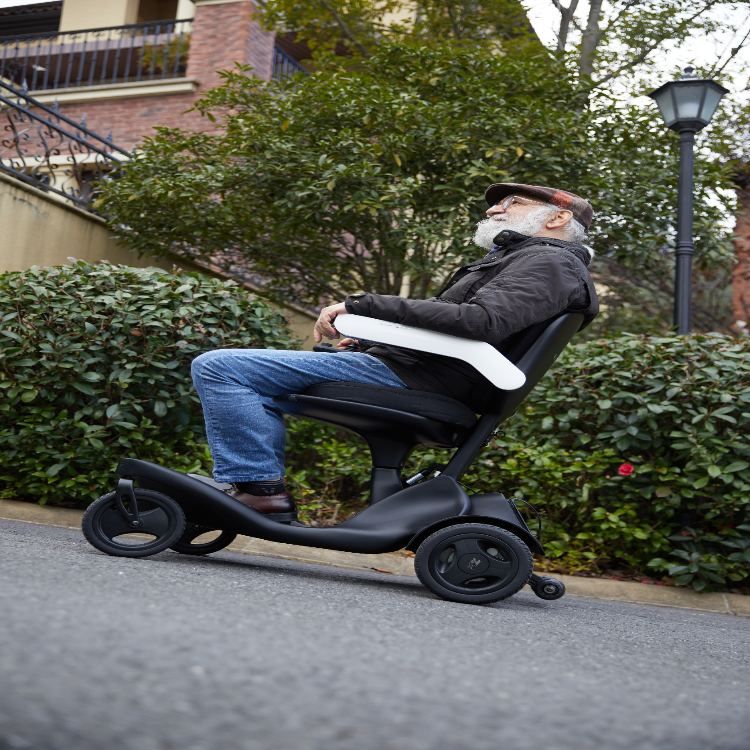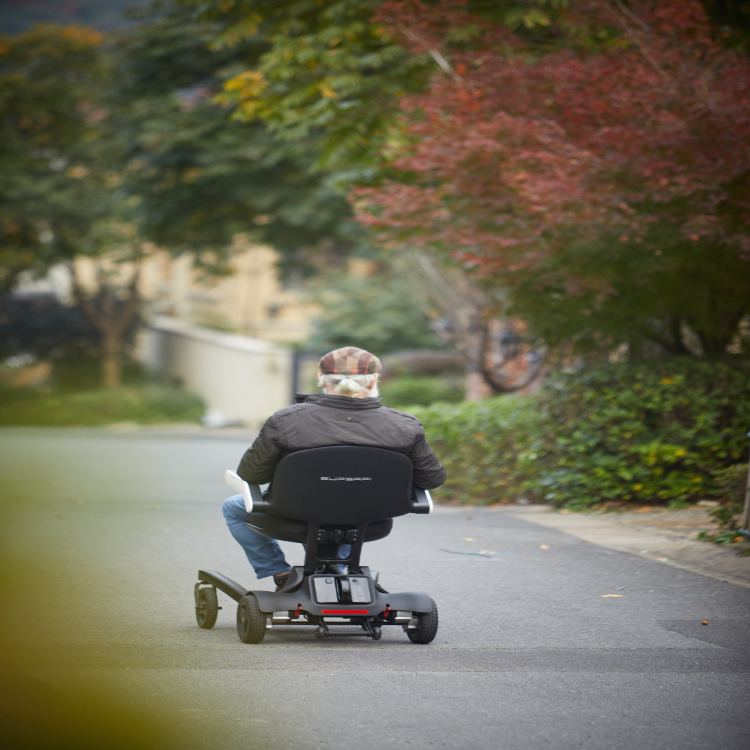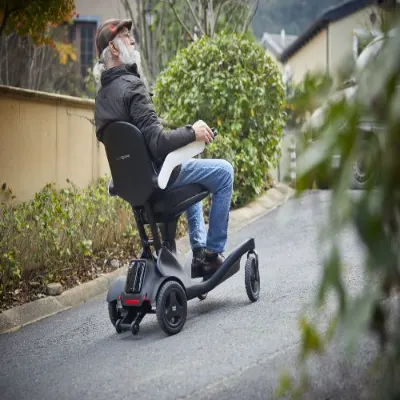
When evaluating электрические инвалидные коляски, battery life is a crucial factor influencing daily mobility and independence. The real driver of range is how you move through the day: the speed you hold, the hills you climb, the weight you carry, plus a few habits that either burn watts or save them. A compact platform with dual 250W brushless motors, a 6 km/h top speed, confident brake-hold on 10° ramps, IPX4 splash protection, independent rear suspension with sealed rubber damping, and a ~21 kg frame without the battery sets a useful baseline for the tips below.
What Variables Really Decide Range in Daily Use?
Think of an “energy triangle”: speed profile, grade profile, and payload. Secondary factors—surface, tires, temperature, stop–start rhythm—push the number up or down by smaller amounts. A chair that starts smoothly, tracks straight, and stops cleanly wastes less power than one that surges and corrects every few meters. Dual brushless motors with an integrated controller help keep torque predictable at low speed, which trims those little spikes that nibble at range.
Why a Simple Baseline Helps?
Specs are meant to be repeated. A 6 km/h cap, 10° climbing ability, and stable release-to-stop behavior give you consistent test laps, so your notes from week to week actually compare.
How Does Speed Affect Draw?
Top speed is only part of the story. Acceleration and braking are the silent culprits. Indoors, 3–4 km/h keeps you flowing with crowds. Outside, 5–6 km/h suits most sidewalks. Hold a steady pace when you can; save the quick bursts for crosswalk gaps.
Why Do Acceleration Spikes Matter More Than Cruise?
Every hard launch is a mini hill. The controller dumps current to get you moving, then you bleed it off as heat when you brake. Set gentler acceleration settings for indoor profiles and use a calmer ramp-up outside when tiles are wet. Your day won’t feel slower, but your battery gauge will sink less by lunch.
How Do Hills and Ramps Change the Math?
Even short ramps at 8–10° act like sprints. Current rises, temperature rises, and you pay twice—during the pull and for a few minutes after as things cool.
What Happens on 8–10° Climbs?
If the chair holds confidently on a 10° incline and stops instantly when you release, you avoid the “roll back then relaunch” dance that wastes energy and rattles nerves. Brake-hold plus steady torque on climbs is worth more range than a slightly higher speed cap.
How Do Short, Repeated Ramps Compound Losses?
Stack three ramps and the draw peaks stack too. On routes like that, ease the launch strength by one notch and point straight before the pull. Those two tweaks tame slip and save watt-hours without costing minutes.
For a quick spec refresher around hill climbing impact, skim the product overview and match your steepest segment to the chair’s rated angle.
How Much Does Payload Really Cost You?
Weight hurts most where you already struggle: on ramps and rough patches. On flat ground, +5 kg is modest; on a climb, it bites.
What Is the Impact of +5 kg, +10 kg?
Expect a small hit on flats and a noticeable hit on hills. If you carry groceries, split heavy items or keep them tight to the seat post rather than hanging off one side. That lowers steering effort and reduces micro-slip on glossy tiles.
Where Should You Put the Weight?
Low and centered. Front-heavy bags make starts twitchy, which leads to over-correction and more draw. A tidy center of gravity feels calmer and rides farther.
Do Stop–Starts and Cornering Eat More Energy Than You Think?
Yes. Doorway hesitations and zig-zag corrections gobble range because they multiply launches.
Which Micro-Habits Save the Most?
Soft launch, early coast, straight entry before ramps. Keep elbows in at door frames, pick a line in the aisle, and hold it. It sounds fussy; it works.
How Do Tight Turns Affect Consumption?
A small turning radius with omnidirectional front support lets you pivot cleanly in elevators and narrow corridors. Less shunting means fewer starts. The front assembly and swept-wing support on this platform are built for smooth 360° spins—handy when the car is half full.
How Do Tires, Pressure, and Surfaces Shift Range?
Rolling resistance and slip are the trade. Solid tires avoid flats and, with fine tread, hold well on polished stone. Pneumatics can roll lighter on long, clean runs but add upkeep.
What Is the Right Pressure Window?
Too hard and you chatter, too soft and you drag. If you find yourself tapping the brake over plate seams, the suspension and tire setup need a nudge. Independent rear suspension with sealed rubber damping cuts that chatter so you coast more and stop less.

How Do Temperature and Weather Affect Output?
Cold lowers effective capacity; wet reduces grip and tempts wheel-spin. Warm up indoors, then keep the first ten minutes smooth. On rainy days, adopt longer coasts into entrances and softer starts on metal plates.
What Simple Warmup/Control Tweaks Help?
Set an indoor profile with gentle acceleration settings and higher brake assist. Outside, keep traction control snug on slick tiles and back off once you hit dry pavement.
Which Controller Behaviors Improve Efficiency?
Release-to-stop that actually holds, predictable ramp-up, and anti-rollback on slopes. You ride calmer, which means steadier current draw and better electric wheelchair battery life. Dual 250 W brushless motors paired with an integrated controller are a solid foundation for that feel.
How Should Indoor and Outdoor Profiles Differ?
Indoors: 3–4 km/h cap, soft launch, tight steering response. Outdoors: 5–6 km/h cap, moderate launch, slightly lower steering sensitivity for straighter tracking. Switch profiles where the surface changes; it becomes second nature.
What Simple Method Converts SOC to Distance?
Log one familiar loop. Write down “kilometers per 10% SOC.” For planning, use 80% of the pack and keep 20% in reserve. Add a small haircut on hill-heavy or cold days. It’s crude, yet it beats guessing—and it respects the day you actually ride, not the one on a brochure.
Introduction to Super Pi Robot
Super Pi Robot focuses on lightweight, travel-ready power chairs designed for real buildings and daily city routes. The current platform pairs an integrated controller with dual 250 W brushless motors for calm launches and confident stops, which supports steady pace indoors and 5–6 km/h sidewalk flow outdoors. A compact footprint around 960 × 600 × 945 mm pivots cleanly in elevators, while a standing fold near 960 × 600 × 380 mm parks neatly beside a closet or in a rideshare trunk. The frame weighs about 21 kg without the battery, making lifts more realistic, and the chair carries up to 120 kg. IPX4 splash resistance suits rainy errands, independent rear suspension with sealed rubber damping smooths plate seams and curb cuts, and a 10° climbing spec with true brake-hold keeps starts and stops composed on ramps. The net effect is simple: fewer corrections, steadier draw, and more predictable range.
FAQ
Q1: Which matters more for electric wheelchair battery life, speed or acceleration?
A: Acceleration. Hard launches spike current; steady cruise at sensible caps uses far less per kilometer.
Q2: How big is the hill climbing impact on range?
A: Short 8–10° ramps act like sprints. Expect higher draw during the pull and a small residual hit after while components cool.
Q3: Where should cargo sit to save energy?
A: Low and centered, close to the seat post. It reduces slip on starts and keeps steering effort down.
Q4: Do solid tires hurt range compared with pneumatic?
A: Not necessarily. On mixed tile and concrete, solid tires with fine tread prevent slip and avoid flats; suspension tuning then does the comfort work.
Q5: What’s one setting you should adjust first?
A: Acceleration settings. Softer launch indoors and moderate outside will usually add distance without adding time.






